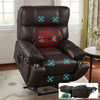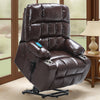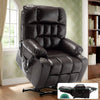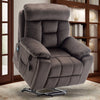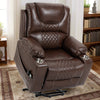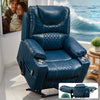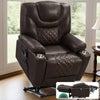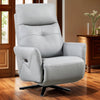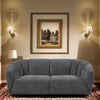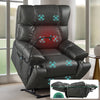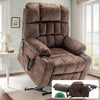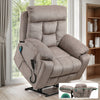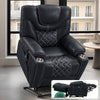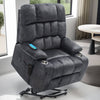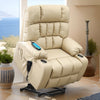Understanding Lift Chairs: A Primer for Elderly Mobility
What Are Lift Chairs?
Lift chairs are specialized recliners designed to help elderly or mobility-impaired individuals. They look like normal chairs but have a powerful lifting mechanism. This mechanism gently tilts the chair forward, assisting the user to stand up easily. Lift chairs come in various styles and sizes to suit different needs. They often feature plush padding and soft upholstery for comfort. Some models offer heat and massage functions for extra relaxation. These chairs can be a game-changer for seniors who struggle with sitting or standing.

The Importance of Lift Chairs for the Elderly
Lift chairs play a crucial role in maintaining independence for older adults. They reduce the risk of falls when standing up or sitting down. This is vital, as falls are a leading cause of injury among seniors. Lift chairs also ease the strain on joints and muscles, which is beneficial for those with arthritis or back pain. They promote better circulation by allowing easy position changes. Moreover, these chairs can boost confidence and reduce reliance on caregivers. For many elders, a lift chair means the freedom to relax without fear of getting stuck.
Key Features to Look for in Lift Chairs
When choosing a lift chair, several key features should be considered:
- Lifting capacity: Ensure it supports the user's weight
- Number of positions: More positions offer greater versatility
- Fabric type: Look for durable, easy-to-clean materials
- Battery backup: Important during power outages
- Remote control: Should be easy to use with large buttons
- Size and fit: Must suit the user's height and room space
- Extra features: Heat, massage, or built-in cup holders
- Warranty and customer support: Important for long-term use
Quality construction and a smooth lifting mechanism are also crucial. The best lift chairs, like golden power lift chairs, combine comfort, safety, and durability.
Assessing the Best Lift Chairs for Elderly Use
Evaluating Comfort and Safety Features
Comfort and safety are top priorities when selecting a lift chair for elderly users. Look for chairs with ample padding and supportive backrests. The seat should be wide enough to prevent feeling cramped. Armrests should be at a comfortable height and width. Safety features are equally important. Anti-tip mechanisms prevent the chair from tipping forward during lifting. Some chairs have sensors that stop movement if an obstacle is detected. Non-slip upholstery helps prevent sliding. Smooth, quiet operation is crucial to avoid startling the user.

Consider chairs with lumbar support for back health. Heat and massage features can provide extra comfort for aching muscles. The lifting mechanism should operate slowly and steadily. This ensures a gentle transition from sitting to standing. Look for chairs with easy-to-use controls, preferably with large, clearly labeled buttons. Some advanced models offer memory settings for favorite positions. Always test the chair's comfort and safety features before making a final decision.
The Top Lift Chairs on the Market
Several lift chairs stand out for their quality and features:
- Golden Technologies MaxiComfort: Known for excellent lumbar support
- Pride Mobility VivaLift: Offers smooth operation and multiple positions
- La-Z-Boy Pinnacle: Combines comfort with a sleek design
- Mega Motion Infinite Position: Features a quiet motor and durable frame
- Catnapper Power Lift: Offers extra-wide seating for larger users
These chairs vary in price, but all offer reliable performance. The Golden Technologies models are often praised for their durability. Pride Mobility chairs are known for their advanced features. La-Z-Boy brings its reputation for comfort to the lift chair market. Always read user reviews and consult with healthcare providers before making a choice.
How to Match Lift Chairs with Individual Needs
Matching a lift chair to an individual's needs requires careful consideration. Start by assessing the user's height and weight. This ensures proper fit and support. Consider any specific health conditions or mobility issues. For example, those with back problems may need extra lumbar support. Users with arthritis might benefit from heat and massage features. Think about the room where the chair will be used. Measure the space to ensure the chair fits when fully reclined.
Consider the user's daily routine. If they spend a lot of time in the chair, comfort is key. For those who enjoy reading or watching TV, look for chairs with good head and neck support. Some users may need a chair that can recline to a fully flat position for napping. Others might prioritize a chair that's easy to clean. Always involve the user in the decision-making process. Let them test different chairs if possible. Remember, the best lift chair is one that meets the user's specific needs and enhances their quality of life.
Installing and Maintaining Your Lift Chair
Step-by-Step Guide to Installing Lift Chairs
Installing a lift chair is generally straightforward, but care is needed:

- Choose the right location: Ensure enough space for full recline
- Unpack carefully: Check for any shipping damage
- Attach the back: Usually slides or clicks into place
- Connect power: Plug into a grounded outlet
- Test all functions: Ensure smooth operation of all positions
- Adjust settings: Set lift speed and recline angles as needed
- Place the remote: Within easy reach of the seated position
- Review safety features: Familiarize with emergency stop functions
Always refer to the manufacturer's manual for specific instructions. Some models may require professional installation, especially for heavier chairs or those with advanced features.
Routine Maintenance Tips for Lift Chairs
Regular maintenance keeps your lift chair in top condition:
- Clean upholstery weekly with a soft brush or vacuum
- Wipe spills immediately to prevent staining
- Lubricate moving parts annually, following manufacturer guidelines
- Check electrical connections monthly for wear
- Tighten loose screws or bolts as needed
- Test the battery backup system every six months
- Inspect the lifting mechanism for any signs of wear
- Keep the area around the chair clear of obstacles
Following these tips can extend the life of your lift chair. It also ensures safe, reliable operation for years to come. Always use manufacturer-approved cleaning products to avoid damaging the upholstery.
Troubleshooting Common Issues with Lift Chairs
Even well-maintained lift chairs may encounter issues. Here are some common problems and solutions:
- Chair not lifting: Check power connection and fuse
- Jerky movement: Lubricate mechanisms or call for service
- Strange noises: Tighten loose parts or seek professional help
- Remote not working: Replace batteries or check for damage
- Fabric tears: Use manufacturer-approved repair kits
- Reclining issues: Check for obstructions or call technician
- Uneven lifting: Ensure chair is on a level surface
- Overheating: Unplug and contact customer support
For any persistent issues, contact the manufacturer or a certified technician. Never attempt major repairs yourself, as this could void the warranty or create safety hazards. Regular professional servicing can prevent many common problems and ensure your lift chair remains a reliable aid for mobility and comfort.








